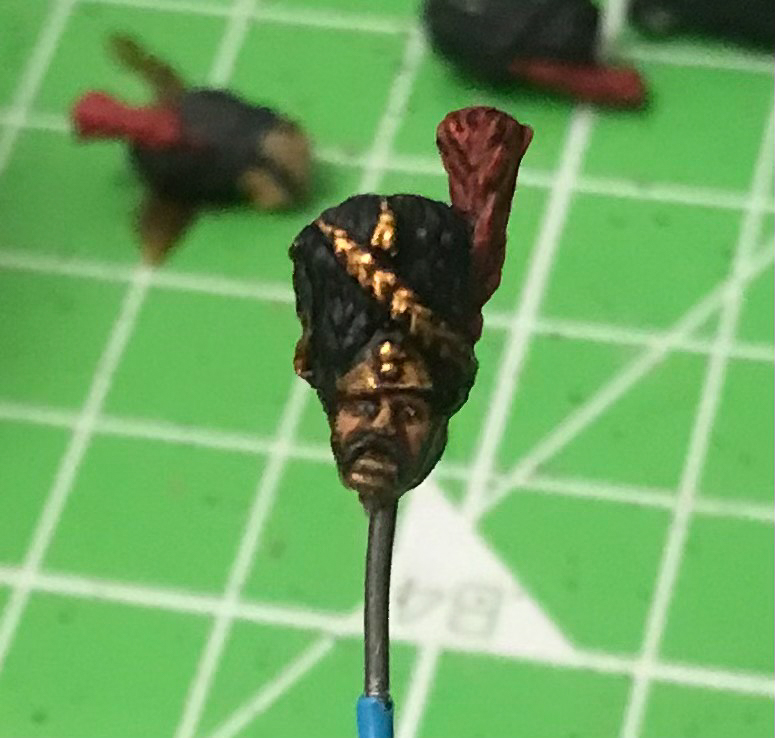Breaking News: Napoleon is Dead
This urgent update interrupts your scheduled rambles about horses. As we go to press it is May 5th, 2022. Napoleon has been dead for 101 years and we would like to mark this solemn occasion with a note on the man himself.
Napoleon. Emperor, Consul, possibly short but also possibly really quite average in height, husband, father, brother, Frenchman. Whatever could we say about Napoleon that has not already been written? He was a noted lover of body odour. One of the greatest generals the world has ever seen. Also, a complete and total bastard. Dictator, sexist, racist, slavery-law-reintroducer. The glamour of Napoleon, Wellington and Nelson is soaked into Napoleonic wargames, where those collecting the pretty armies of Red, Blue, White, Green and Black, are allowed to ignore the crushing brutality of the English, French, Prussian, Austrian and Russian government systems and roll our lovely dice and paint our lovely men. There are few to no good guys in the period. Napoleon, had he chosen to, could have been one of them. But he didn’t. So RIP to a complex guy who was really a shit in all important ways.

We now return to your regularly scheduled programming.
Some of those that Paint Horses
I don’t understand the fascination people have with horses. Cows, I understand. Large stocky bastards, literally beefy, delicious, environment-destroying and the progenitors of my favourite outerwear item of clothing, a jacket I picked up for about a tenner in 2018 that is rapidly reaching the end of its useful life. But horses are weird stilt legged jittery things always dying of mild shock or eating a common flower, fit only for the upper classes to sit on in their pathetic hunts where they gang up 50-60 toffs in order to rip a single fox to shreds. I think maybe it’s something I missed in my upbringing, where I grew up poor in a household where food scarcity was harsh enough that a pony was a dream Christmas present – as long as it was cooked – rather than in a raw, gamboling and living form. Regardless, the horse fascination many people seem to have passed me by.
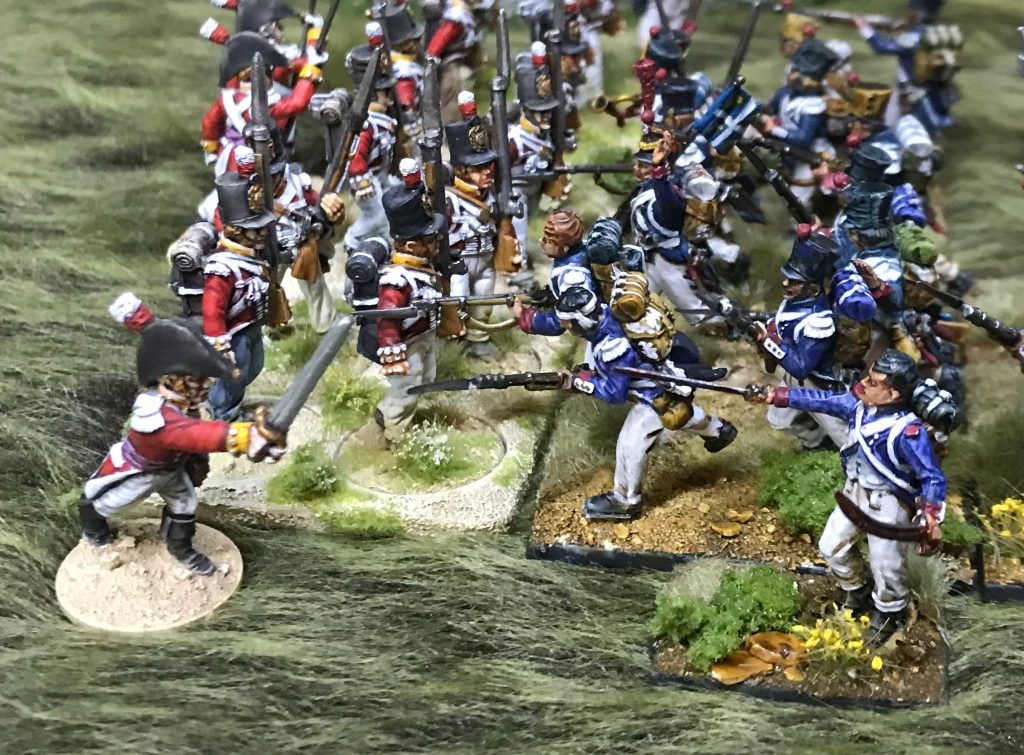
This has extended to my wargames too. I rarely use cavalry unless it’s giant wolf or spider related, my English civil war army has 60 infantry and literally two horsemen, and up until right now I’ve managed to paint 5 chonky batallions of the Grande Armee without touching a single horse. But, much to my disgust, cavalry were apparently an important part of Napoleonic armies, and a recent battle at a mate’s house proved to me that I needed to move from a stately walk to whatever else horses do – gallop? canter?
Are the same that wield Forces
If you’ve been reading along and you’ve got the eagle eyes of a flanquer-chasseur, you’ll have seen that horsemen have been sat half-built and even half-painted on the Napileon of shame for the entire length of this series. One of the first sets I bought was the Perry’s plastic Cuirassier set, giving me 12 of the biggest, most heavily armed and no-nonsense cavalry in the French army. It’s been a monumental effort summoning up the courage to paint horses, but they are finally done, and they look pretty great even if I say so myself.

While I’m never going to say I enjoyed painting anything on the back of a horse, the process of modelling this big weird unit was a lot of fun, as with every bit of research I did on the Cuirassier squadrons the more I wanted to incorporate what I was finding into the project. These were the biggest men on the biggest, blackest horses. Impeccably dressed, heavily armed, fairly well trained, they were a solid mass of man, horse meat and steel, the literal heaviest cavalry in European armies at the time. No subtlety in dress or tactics. If the Guard were the anvil upon which any enemy would break, the Curiassiers were the anvil dropped off a canyon on to Wile E Coyote’s head – fast, dense and flattening. So they have to be literally modelled en masse, right? At the charge, in a big block. Decision made.
After making the big base, and sticking down the first four (offset from each other so that they can be easily painted), more reading into French cavalry and cavalry tactics, revealed that the Curiassiers were the iron core of mass, suicidal and unsupported charges often commanded by noted crazy men Marshals Murat and Ney. Cuirassiers took the great redoubt at Borodino, a cavalry charge into a bloody fortress followed by an insane melee. Cuirassiers broke Wellington’s squares by charging at them repeatedly at Waterloo, a feat of arms unlikely enough that Anglophone historians still say it couldn’t possibly have happened. So they need to be a big base of big hard men, but they also need to be big hard men getting shot up, killed, thrown off horses and still making it in to base-to-base contact. Another Perry set – Curiassiers hit in the groin with football under fire, gave me some great casualties to add in to the ranks. It also let me move some of the plastics over to a different squadron, giving me just enough to do two bases of eight, or leaving some for individual and small group bases in games where casualty removal is a thing. All told, they look like a solid mass of horse and stone cold bastard, so I’m happy. Or was.
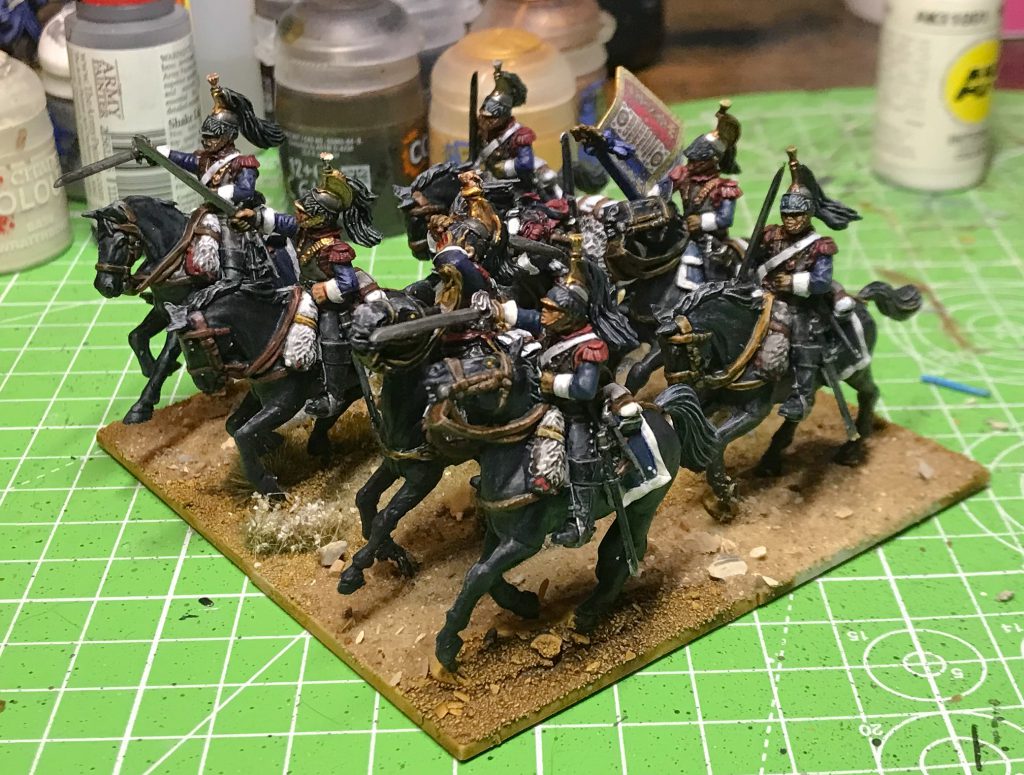
Ugh!
If there is a pattern to this project, it’s of me not properly looking ahead at what I’m making and building before actually doing it. I’d naively assumed that because there were Cuirassiers of the Guard at Waterloo*, there always had been. Unfortunately not! Guard Cavalry lacked any Cuirassiers until 1815, so these guys shouldn’t be Cuirassiers at all, but Horse Grenadiers – still heavy cavalry, still used with all the subtlety of a half brick to the face, but without the cuirass, and swapping the helmets for the classic Old Guard bearskin. There’s nothing I can do about the armour without just buying entirely new models (no), but with a couple of twists and some clipper-based savagery worthy of the Jacobins themselves, a headswap gives me the 1eme Grenadiers a Cheval, who have temporarily liberated some armour for themselves.
The Grenadiers a Cheval were nicknamed “The Gods”, so far above the ego of the standard cavalryman that standing orders forbade women under 40 coming into their barracks, making them not only anecdotally but institutionally and legally dangerously handsome. The Guard rode the biggest horses that could be bought, pillaged or stolen from Europe (16 hands, apparently – why the hell are horses measured in a bespoke imperial measuring system? Absolute nonsense), all of them so black they could double up as a Spinal Tap album cover. They famously took on their Russian counterparts mano-a-horso at Austerlitz a concentration of big giant men on big giant incredibly dumb horses that gathered a lot of attention while infantry under Soult and Davout did all the hard work.
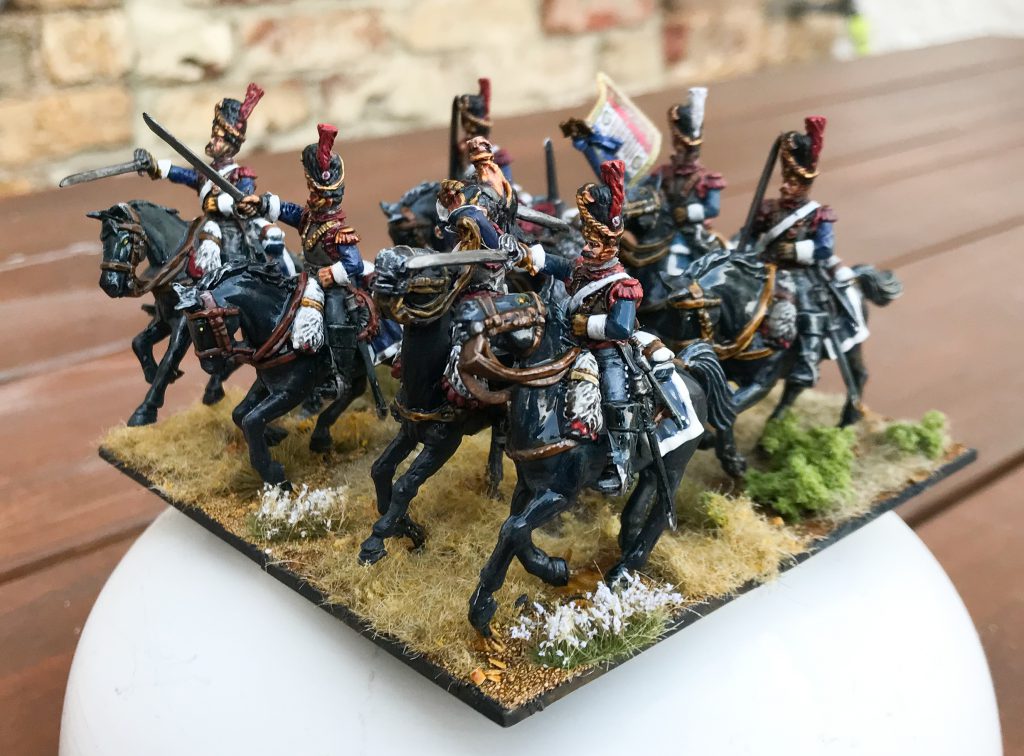
They will, hopefully, play the same role in my army as they did in real life as the big egotistical ICBM that lurks just behind the infantry, ready to leap in and absolutely mulch anything that presents the slightest opportunity. Where games offer specific rules for the Grenadiers a cheval, they’re as you’d expect – the best soldiers, the hardest rules and the most combat power available. In Black Powder they are able to throw off hits to morale, command themselves and are almost guaranteed to break a line on the charge. No flank, rear, cavalry squadron or artillery is safe from a thunderous, line-breaking charge of Napoleon’s Gods, the horseclear deterrent.
Upskilling in the Name Of
Painting these guys was a hassle. I went for the straightforward white, blue and red of the 1eme Curiassier regiment, but my experiments with doing everything with contrast paints didn’t really work, and I never settled on a single good way to paint black horses. They’ve come out a little more cartoony than the infantry because of the liberal use of an army painter dark tone bottle that either worked exactly as it was supposed to, or had something seriously wrong with it, as it appears to have shrink-wrapped the models in a near-transparent black film. To make them “perfectly accurate” Grenadiers, I would go back and paint the legs white and re-do the epaulettes, trim around the saddle cloth and various other bits gold, but having just ripped the heads off eight fully painted horsemen, my patience for further fucking around with this unit is minimal to none.
The horses themselves are mostly basecoated black mixed with a smidgeon of Citadel Dark Reaper or Eshin Grey. A pure black wash applies shade on some and on others black templar contrast does the same job. A light drybrush of dark grey around the face and feet, followed by a slightly lighter grey highlight very sparingly around the face, give them the strange, impossible eyes that horses have – I went mostly yellow for that “horses are fucking weird” feeling, and then splash some washes, flick some brown paint and sponge on some dust to suit.
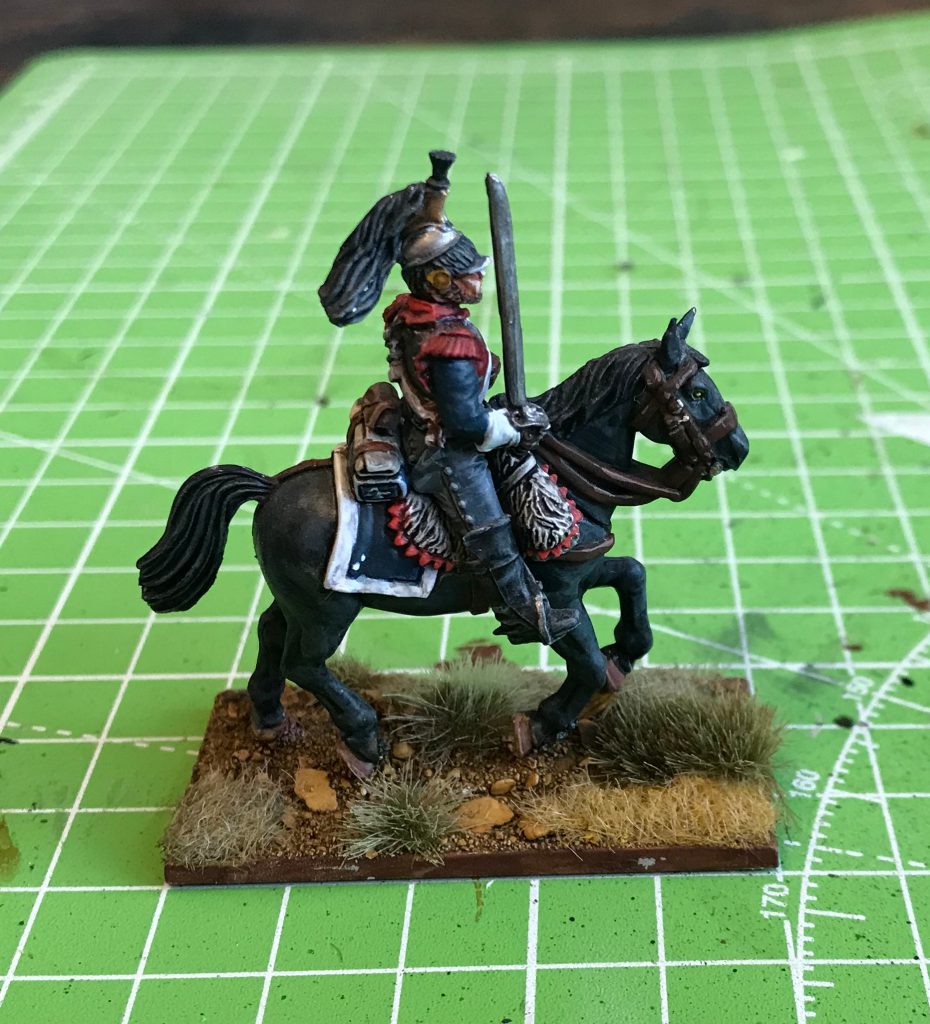
Other horse colours will, I guess, follow a similar pattern, but I think you’d be surprised at how much research I am willing to do to ensure that I only ever have to paint black horses again.
Come on, come on!
I remembered this month that I work in a university, with a Library, so I can take out anything and access more or less any journal. So there’s been some academic reading (Soldiers, Citizens and Civilians, Forrest et al editing) and then a flurry of reading about Haiti. CLR James’ Black Jacobins is exactly my kind of history: exciting, anti-colonialist, marxist and about a really interesting guy, and Sudhir Hazareesingh’s Black Spartacus brings scholarship on Toussaint L’Overture right up to date. It would be a shoe-in therefore to make Toussaint our badass this time round, but his sheer brass ball courage deserves its own article and inspired me to do more reading around race and ethnicity in the Napoleonic era, so he will get his own entire article soon. Instead, I’m going to give it to whichever goddamn brain came up with the “initiation” ceremony for the Curiassiers as reported in Elting’s Swords around a Throne:
One of French cuirassier regiments developed a unique test for newly assigned officers. You were given 3 horses, 3 bottles of champagne, and 3 willing girls and 3 hours to kill the champagne, cover the girls and ride a 20-mile course. Of course you could draw up your own schedule of events.
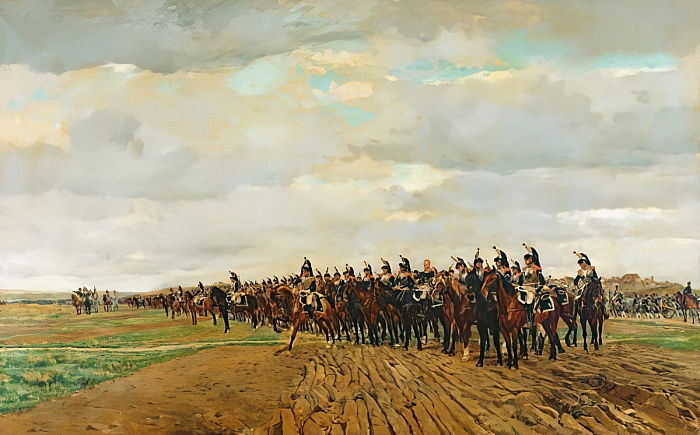
The Cuirassiers before their Charge at Austerlitz, Jean Louis Meissonier
The badassery isn’t in doing this, because to be honest I doubt anyone did, but in making people believe you did 200 years on. If there’s a better way to secure your legend as a “manly man’s man” making up some total bollocks that you totally had to do to get in, I swear, as opposed to just “being a big guy who could ride a horse”, I don’t know what it could possibly be. It’s all the better when you know that French cavalry was feared, but not respected – legendary for poor control, poor horsemanship and poor discipline. At best, the Curiassier could complete two of the three tasks, and one of them was never going to be ride 20 miles in three hours.
Nice time: scale(c)tricks
*Even then, find me two sources that agree that there were!

